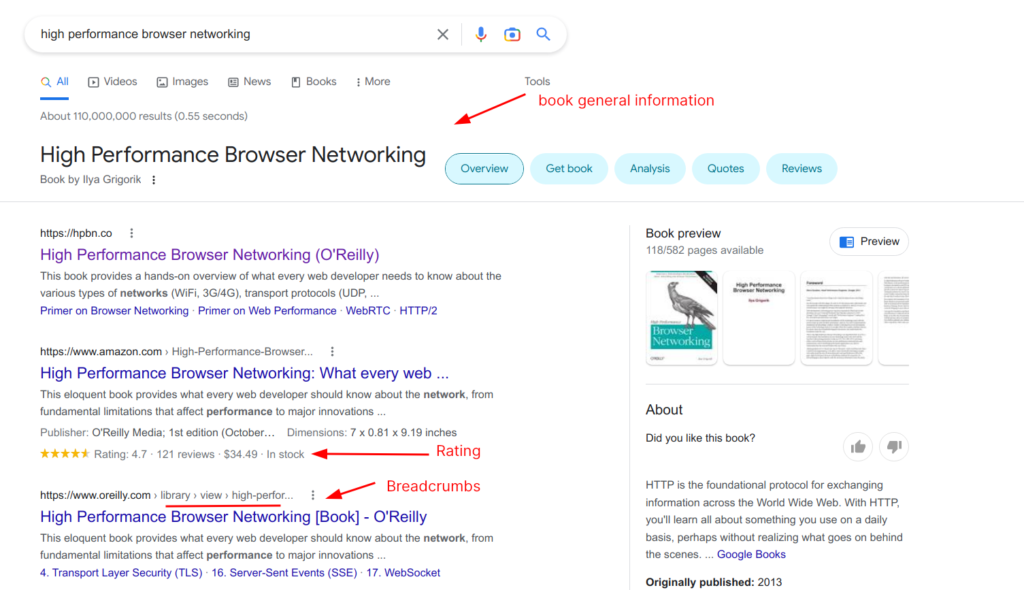Google – the biggest search engine, has over 99,000 searches every single second (Internet Live Stats, 2022). Then we can calculate the number of searches is over 8 billion a day. It’s incredible.
Therefore, bringing your website to appear on search engines is an extremely important step in marketing. This is called SEO – Search Engine Optimization.

SEO includes two parts:
- On-page SEO: Structuring and optimizing the website’s code in order to make it easier for users and Google crawlers to access. In this article, we’ll go into greater detail about this technique.
- Off-page SEO: They are techniques to improve Google search results by indirect methods such as creating backlinks, creating satellite websites…
As a developer, we should focus on the On-page SEO technique, and below are the TOP 5 on-page SEO techniques that every web developer must know.
Core SEO knowledge
Content is KING!
Bill Gates
According to Bill Gates’ quotation, people are looking for the content they need, hence the content that is put on the website is the most important. In some cases, it’s unnecessary to over-optimize SEO because Google will give you a priority if your website content is valuable and users need it.
Then before doing anything about SEO optimization, focus to create valuable content.
Apply good HTML & Schema markup
An SEO-friendly website firstly must have a well-structured HTML markup.
There are some essential parts of an SEO-informative website:
- In the head section: Besides the title tag, the meta tags are extremely useful tags for google in evaluating your website. We have two common meta tags:
meta descriptionand metakeywords. In addition, the open graph tags (meta og) are very helpful for you to control how URLs are displayed when shared on social media. - In the body section: You can use the semantic language of tags (or microdata) from schema.org (commonly referred to as “Schema”) to enhance the way search engines understand and display your website in SERPs.
A website that uses the appropriate semantic schema tags will provide search engines with a lot of informative data.
For instance, a book will have certain details like the genre, author, publishing date, and rating, etc… With just normal<p>text tags, Google will have an extremely difficult time gathering the necessary information.
A visual example while applying schema is described below:

Additionally, a page needs to contain a sufficient number of heading tags, image elements must always have an alt and title attribute, and so on. We can delve further into the following skill, writing SEO-friendly articles.
Write SEO-friendly content
As I mentioned above, a good SEO article must have the right number of headings tags (H1 – H6).
Normally, H1 will be the title of the post, you can open the developer tool and check it now while reading this. Next, the article’s content should determine how many corresponding h2-h6 tags are used.
That completes the post’s structure, then we can go to writing the details. I have some advice for this:
- Use the focusing SEO keyword in the title
- Write related keywords/ synonyms in the paragraph
- Use transition words
- The image name and title/alt attributes should be related to the writing content.
- Avoid too-long sentences.
Optimize website time load
A significant portion of website visitors will quit if the page loads just after 3 seconds. Additionally, around 80% of people who have encountered bad performance permanently skip the pages and never return.
This shows the importance of the website’s loading times. This depends on 2 factors:
- Server responding time
- Coding optimization
If you want to reduce the server response time? Pay more and get more powerful hosting or VPS.
But some pages required too many unnecessary resources (unused javascript files, CSS, fonts…), or just simply have very big images.
There are tips for optimizing the time load:
- Compress and optimize uploaded images (using any plugin, or just code it!)
- Cache the web page (cache the rendered HTML server side, use browser caching…).
- Compress responses in gzip format.
- Do not use a big js file for all pages, just split it out and load it when it is necessary.
- Minify Js, CSS, and HTML.
- Use lazy loading for images
- Use defer and async when loading scripts
- many more…
Google has a very powerful tool for checking your site’s loading time and on-page SEO overall. It is page speed insight.

Focusing on user experiences
The final topic I want to tell you is UX – user experiences, just focusing on it.
Put yourself in users’s position
When exploring the internet, and finding out your needed content, you may expect the blog or website to provide you the easy to read, clear, helpful information.
There are some tips for the SEO related UX:
- Link related posts in the article content, or customize the relevant posts algorithms (by keywords, tags…)
- Be fast
- Navigation between pages should be easy
- A clear web layout
- An attractive and clear logo
- Care about the typography (choose the correct fonts and font weights)
- I hate dark mode when it’s not at night, so use the dark mode sensibly
- …
Above are the top 5 must-know SEO skills for developers. Hope that help!